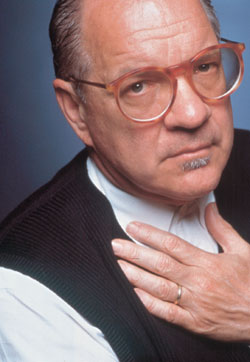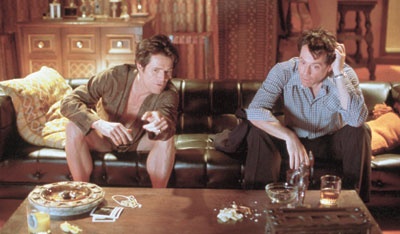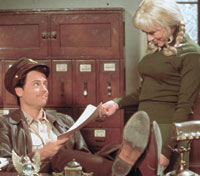I AM A CAMERA
In Auto Focus, Paul Schrader furthers his fixation on compromised masculinity with the true tale of sitcom star, proto-swinger and porn addict Bob Crane. Travis Crawford discusses it all with the writer/director.
 |
| Greg Kinnear and Rita Wilson in Auto Focus. PHOTO: FRANK MASI. |
On the surface, the subject matter, director and cast of Auto Focus seem like such a bizarrely ideal match that the entire project almost has the feel of a grotesque high-concept parody, a TV sketch-comedy skit brought to life. Auto Focus chronicles the strange life and eventual unsolved murder of Hogan’s Heroes sitcom star Bob Crane, from his mid-to-late-1960s straight-arrow family-man lifestyle and initial television success, through the pornography addiction, mania for “swinging” and questionable friendships that led to his 1978 bludgeoning in an Arizona motel room.
Schrader’s casting of genial former TV personality Greg Kinnear to portray the smarmy if amiable Crane is remarkably astute, as is the selection of the incessantly unhinged Willem Dafoe to play Crane’s cohort John Carpenter (no, not that one), a parasitic video technician who lured Crane into a life of sexual experimentation. And who better to chronicle this addictive union and self-destructive behavioral spiral than a filmmaker who has specialized in the depiction of masculine identity in crisis, through his own films as a director (Affliction, Mishima, Blue Collar), as well as screenplays for Martin Scorsese (Raging Bull, Taxi Driver, Bringing Out the Dead).
But Auto Focus surprises by handling such seemingly predictable grim and lurid material with an often jocular, satirical, tongue-in-cheek flair, a stylistic choice which may confound those expecting one of Schrader’s usual somber tours through the seedy alleyways of human depravity and male self-loathing. Despite swimming in similarly sleazy narrative waters, Auto Focus is a considerably cheerier endeavor than Schrader’s Hardcore. Schrader’s most cleverly subversive flourish hinges on the often disorienting shifts in tone that accompany Crane’s descent, and the visual techniques employed by the director and d.p. Fred Murphy to mirror this collapse.
Auto Focus begins as a jaunty and colorful examination of Crane’s newfound fame and family tensions, with Schrader employing a static cinematic vocabulary not far removed from, appropriately enough, TV sitcoms. (As his previous film, the wrongly neglected melodrama Forever Mine, indicates, Schrader is adept at the appropriation of film styles to convey specific periods.) But as Crane’s immersion into this new lifestyle escalates, Schrader and Murphy gradually and subtly alter the visual landscape by bleaching the image, desaturating the color and moving from stable camerawork to increasingly jagged and unnerving handheld movement — just as Angelo Badalamenti’s score shifts from lounge jazz to ominous synth drones reminiscent of his work for David Lynch.
 |
| Director Paul Schrader. PHOTO: ROBIN HOLLAND. |
In documenting the dichotomy that exists between the public and private life of a minor celebrity, Schrader is aided immeasurably by the surprising chemistry shared by Kinnear and Dafoe in their roles; though the duo would appear to be as dissimilar as any two actors working today, they create a wholly believable bond, best evidenced in the film’s most startling sequence, as Crane and Carpenter casually discuss the wonders of emerging video technology while engaged in a mutual masturbation session. But there are also devices employed by Schrader that don’t work as successfully: Crane’s glib Sunset Boulevard-esque voiceover feels gratuitous and distracting, and a daydream sequence involving an orgy on the set of Hogan’s Heroes is a garish miscalculation (albeit one that is in keeping with Schrader’s initial TV sitcom aesthetic).
Auto Focus reaffirms Schrader’s position as one of America’s most consistently compelling independent filmmakers, particularly after the triumph of his Russell Banks adaptation, Affliction (1997). But Schrader’s status as an independent director also provides a revealing case study in the difficulties of sustaining a career as a filmmaker with a personal vision.
Schrader began in the Hollywood studio system of the 1970s, but following Cat People (1982), he moved more into the arena of independent filmmaking, helming medium-budget projects funded largely through foreign interests and ancillary-rights coin. Like Cronenberg and Lynch, Schrader enjoyed mainstream studio successes in the early-’80s, but also opted to leave that world behind to focus on making the type of cinema no longer in vogue with studio interests. As Schrader remarks, it wasn’t he who changed, but the studios — but now, two decades later, he prepares to return to the big-studio battleground.
Filmmaker: So what was your initial reaction when someone pitched the idea of a Bob Crane biopic to you?
Paul Schrader: I had foresworn biopics. I was up to my eyeballs in biopics, and for some reason, I kept getting offered them, and I had become disenchanted with the genre. I had a standing mandate just to turn them all down, so when this came to me, I said, “Don’t bother to send it.” But my agent said I should read this one, so I did, and I saw there a story that had the heft and power of fiction. It was essentially a mid-life American heterosexual TV-star version of Prick Up Your Ears, and it was a story that would’ve been worth telling had it been fictional and was all the more interesting because it was historical. The script needed a considerable amount of work, which I did; then off we went.
Filmmaker: Had you been familiar with Crane’s story at the time of the events?
Schrader: Well, you know, when the show was on, I was in Los Angeles working for the L.A. Free Press, so I was protesting various government activities, and this thing (Hogan’s Heroes) seemed to me to be just about the stupidest show I’d ever seen — as opposed to the fifth-stupidest show, as TV Guide describes it.
Filmmaker: Obviously, you’ve done biopics before — Patty Hearst, Mishima, the Raging Bull screenplay — and you were reluctant to tackle the genre again. What unique problems do biopics present to the filmmaker?
Schrader: People do not have dramatic lives — their lives are a mess, they don’t have dramatic arcs and they usually don’t have a lot of meaning, so therefore, you have to reach in and manipulate events. At some point, this manipulation becomes so artificial that you say, “Why am I bothering? Why don’t I just do a fiction film?” I had been asked to do both the Mitchell brothers and John Holmes [biopics], and I turned them both down, and then I saw Boogie Nights, and I said, “That’s how you do those stories.” Why fool around with John Holmes and the Mitchell brothers — do it as fiction; it’s much better that way. I really don’t like to have to jury-rig history and create characters that didn’t exist and put people in rooms for meetings that never occurred.
Filmmaker: To what extent did you feel obligated to adhere to the actual facts of the Crane case in Auto Focus?
 |
| Willem Dafoe and Greg Kinnear in Auto Focus. PHOTO: FRANK MASI. |
Schrader: Well, as with Mishima and Patty Hearst — less so with Jake LaMotta — everything had to be based on something that actually happened. Obviously once two people get in a room, no one knows exactly how that conversation went down — and it probably went down in a much more banal way than people would bear to watch onscreen. But you have to have an authentic and verifiable starting point. Also it’s easier to do a film about someone who is less well-known, like Jake LaMotta. If you’re doing someone like Richard Nixon, everybody looks at it and says, “Well, I remember Richard Nixon — and that’s just Anthony Hopkins!” Whereas people have vague ideas of Bob Crane, Patty Hearst and Jake LaMotta, so it allows you to go in and orchestrate history a little easier because people don’t have all those facts at their disposal.
In Crane’s particular case, you have someone whose life would not really be worth examination — it was neither entertaining nor educational — were it not for a couple events. One was his obsession with pornography, and the other was his friendship with John Carpenter, so automatically the film skews towards that area. John Carpenter was a part of Crane’s life, but not that big a part, really. You’re taking a smaller part of his life and putting it in the forefront because it was the most interesting thing that happened to him. But those are the natural distortions that are made in historical and biographical films.
Filmmaker: How did you go about rewriting Michael Gerbosi’s original script?
Schrader: Well, I just felt that it had a very conventional biopic feel: He did this, he did that, naked exposition of people saying exactly what’s going on. And there was also not enough Carpenter. So I added three freestanding scenes of Carpenter without Bob, then I added three or four more scenes of Bob with Carpenter. So I just weighted the whole thing towards Carpenter, and I threw out all of the junky biopic connective tissue: Well, then this happened, then that happened! Ah, who the fuck cares? Let’s get to the good stuff — the “good” Bob is a drag!
Filmmaker: The tonal shifts in the film that chronicle Crane’s downfall are aided by the arc in visual approach. How did you go about achieving that with your d.p. Fred Murphy?
Schrader: It’s not an act of genius; it’s just a simple progressive degrading of the image, and an increase in clutter. The camera goes from seamless dolly moves to Steadicam to good handheld, then bad handheld. The color becomes progressively bleached, the production design loses color and the rooms become progressively cluttered. It’s a simple notion, but I think the trick in pulling it off is to make it as seamless as possible, so that at some point, the viewer says, “This is a different movie than I was watching a while ago.” The trick is to hide your tracks.
Filmmaker: Was this the first time you ever shot handheld?
Schrader: Yeah. I’ve never done that Michael Mann, NYPD Blue stuff until this. I was so influenced by The Conformist for so many years that I came from the school of the seamless, graceful move. I had always predetermined the ending [of a shot] — knowing that when the camera comes to a stop, it would be at the perfect composition.
 |
| Greg Kinnear and Maria Bello. PHOTO: FRANK MASI. |
Schrader: They’re very different, and yet they became quite good friends and they still stay in touch. Greg is everybody’s friend from [E! Entertainment Television’s Talk Soup], and Willem is the avant-garde experimental theater actor. That was part of the fun in casting them — it was a kind of “Oscar and Felix Go to the Dirty Movies.” It could’ve backfired, but it didn’t. Greg is also a very clean-cut boy, and he had a lot of trepidation about entering this territory, so I also had to put somebody next to him who didn’t share those trepidations.
Filmmaker: There’s an interesting homoerotic element to their relationship.
Schrader: It is subtext, and it becomes very close to becoming text, but you don’t want it to become text. It’s part and parcel of the era and of who these men are that they can go to all these swing parties and never even think for a second that there’s a homoerotic impulse there.
Filmmaker: And the significance of the title?
Schrader: Self-absorbed. Bob Crane’s sin wasn’t having too much sex, it was being selfish, just caring about himself at the expense of everything else, and being completely clueless about the impact of his actions. And because he was a celebrity of sorts, people let him get away with it.
Filmmaker: In that sense, I guess there’s a connection between Crane and some of the characters in your previous work — Travis Bickle, Jake LaMotta.
Schrader: I do seem to be pretty good at lining up behind these people who don’t get it, and it’s always fun to get an audience to identify with someone who doesn’t get it, because at some point the viewer has to second-guess his identification. The same is true of the character in Affliction — you’re saying, “Wait a minute, there was no murder!” I’m drawn to those characters — Patty Hearst is another one — and I’ve been able to depict them.
Filmmaker: On a subject related to your first-time use of handheld camera, do you still find yourself learning and advancing as a filmmaker, even after all these years? Is it an ongoing process?
Schrader: Yes, you have to, because the rules are constantly changing. There used to be a thing called “the line” — [the 180 º rule] — and you weren’t supposed to cross it. Well, now they’ve erased that line. There are all kinds of things that you can do now that you could never do even a few years ago. The movies I made in the ’70s all look slow to me now. Because technology — and the experiential background of young viewers — is constantly evolving, your style evolves, or otherwise you’re not in tune with your audience. You don’t have to slavishly imitate every music video or CGI extravaganza, but you have to be aware of it. If you’re going to work against the grain of an audience’s expectations, you have to do so with deliberation and not ignorance.
Filmmaker: But it sounds as if these stylistic changes are all rooted in external forces.
Schrader: You have certain elements of your style, but I think that where the rubber meets the road is where your technical knowledge meets the subject matter. Certain historical tendencies will suddenly seem not so important when you really see that you can tell the story better by doing something you haven’t done before.
Filmmaker: What is your next project?
Schrader: I’m taking up the reins from John Frankenheimer for the Exorcist prequel with Liam Neeson. It’s with [d.p.] Vittorio Storaro in Africa, and it will be a return to the big-budget world.
Filmmaker: Is that a good thing or a bad thing?
Schrader: Well, I never really meant to leave the studio system. The system changed, and the movies they were making became less and less interesting. But it just gets so hard to go out with your begging cup year after year and scrounge up the budgets for these films that it will be nice to do something with a larger tableaux from a quality script. I don’t feel like I’m doing something beneath me. It’s been 20 years since Cat People, and it will be refreshing to work the big arena again.
LINKS:
VOD CALENDAR


 See the VOD Calendar →
See the VOD Calendar →


